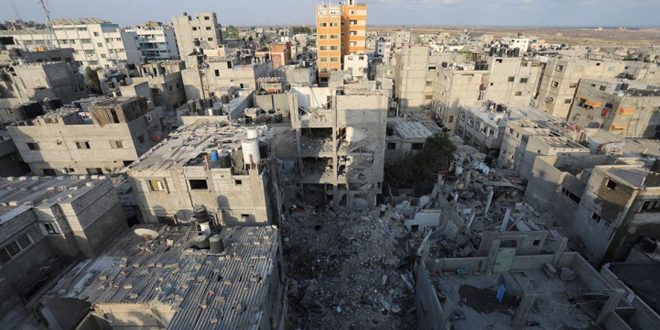American media does not often show scenes where innocent Palestinian women and children were killed in the Gaza Strip
When a ceasefire on Sunday night ended a three-day Israeli offensive in the Gaza strip, over 350 Palestinians were wounded and 46 were dead, including 16 children, according to Palestinian officials. Media coverage in the U.S. was mainly led by photographs of smoke-filled skies or Gazans walking amid piles of rubble. While the photos were accurate and recent, the safety of selecting these images, rather than graphic ones, effectively portrayed a reality for American audiences far removed from what had truly unfolded on the ground.
To look at the totality of images that are made during a news event is an experience most Americans, with the exception of photo editors in newsrooms, rarely experience. As the Palestinian death toll climbed over the weekend, images from photojournalists based in Gaza poured into massive databases like Getty Images and AP Images. A quick search for “Gaza” on Getty Images, for example, returns hundreds of recent photographs, a near-endless grid of brutality from the last week.
In many images, children killed by Israeli bombs are displayed prominently. These images show funerals, the faces of the deceased uncovered, their bodies held aloft and marched through the streets. In some photographs, mourners are seen taking their own images of the bodies on their cellphones — proof of what horrors have occurred.
These graphic images are arrayed, on photo databases, next to the nongraphic images that are almost always selected for publication by U.S. news organizations: Rockets flying through the sky at night, quiet moments of children surveying the damage done to their homes, and black smoke rising over the horizon.
In Gaza, photojournalists routinely photograph within hospitals and morgues. This access to urgent care facilities, rare in the United States, provides an opportunity for journalists to directly document the wounded and dead. On Getty Images, images of children’s bodies, wrapped in white fabric, piling up at the morgue are abundant and uncensored. While shocking and deeply upsetting, they do show very clearly what bombing dense residential areas produces.
“I can still see the grieving people weeping after their homes were destroyed,” Palestinian photojournalist Hosam Salem told The Intercept. “I can’t handle it anymore. Even after these three days of Israeli attacks are over, I have become more drained than before. In Gaza, there are no stories that can give us life; all we can say is how death has taken our lives and the lives of those around us.”
Yet these images are not the defining feature of the unequal conflict in which no Israelis were killed. Instead, they are rarely published at all.
“In general, the majority of coverage by international and American media is weak and often does not show scenes where innocent women and children were killed,” Soliman Hijjy, a Palestinian visual journalist working in Gaza, told The Intercept.
In the case of one of the 16 children killed, 5-year-old Alaa Qaddoum, one report, in the New York Times, included a photograph made after her death. This was the exception, though the photo was not featured prominently; it was placed near the end of the article. Other outlets, from the Washington Post to NBC News, did not publish the image, even as they mentioned the girl’s killing. What we are left with is, in essence, a sanitized and avoidant understanding of world events as newsrooms uniformly opt for images that do not include any graphic content. Social media platforms, like Twitter and Facebook, have enforced this shift away from publishing depictions of violence by implementing “sensitive media” policies that discourage newsrooms from prominently displaying images of atrocities — lest they lose page views.
https://theintercept.com/2022/08/10/israel-gaza-bombing-death-images/

